BEST ROAD BIKE PEDALS

While road bike pedals may not be very sexy or expensive compared to your bike frame, components, and other kit, they are just as important to your performance, comfort, and safety out on the road.
This Know Fast review gives you the essential knowledge you need to decide what road bike pedals to get and where to get them in a brief, enthusiast-focused, ad-free post. I’ve done the same comprehensive, comparative, and conflict-of-interest-free evaluations that normally go into longer In The Know Cycling reviews to come up with my recommendations and insights and write them up in a form that you can more quickly read and act on.
RECOMMENDED ROAD BIKE PEDALS
SHIMANO
I recommend Shimano Ultegra pedals – the PD-R8000 – as one of the two best road bike pedals for most road cycling enthusiasts. They perform well, suit the fit needs of most cyclists, are very durable, and require no maintenance.
At an MSRP of US$200/£160/€195, you can buy Shimano Ultegra pedals at the best prices by following these links to BTD (BikeTiresDirect) 10% off w/code ITK10, Competitive Cyclist, Performance Bike, Merlin, Sigma Sports, and Amazon, stores that I recommend because they have very competitive prices, top customer satisfaction ratings from fellow cyclists as reported by independent services, and a great selection of gear for road cycling enthusiasts.
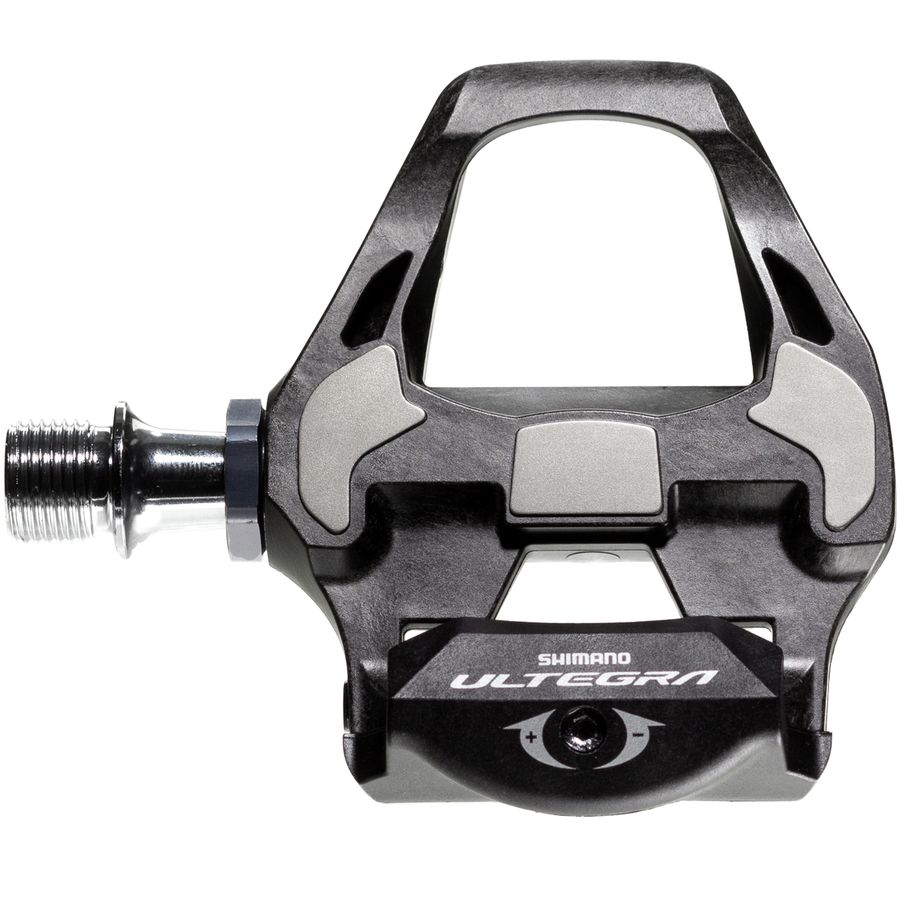
You could spend about 40% or US$80 more on Shimano’s Dura-Ace PD-R9100 road bike pedals, but I see no reason to do so unless you are a committed racer. Likewise, you could save 25% or US$50 less by going with their 105 PD-R7000 model, but the better performance and wider Q-factor option with the Ultegra make it the best solution for enthusiast-level road cyclists.
In The Know Cycling is ad-free, subscription-free, and reader-supported. If you want to help keep it rolling without any added cost to you, buy your gear and kit after clicking the store links on the site. When you do, we may earn an affiliate commission that will help me cover the expenses to create and publish our independent, comprehensive, and comparative reviews. Thank you, Steve. Learn more.
WAHOO SPEEDPLAY
If your biomechanics or bad knees require a fit solution somewhat outside the norm, or you just prefer pedals you can clip in from either side with near-frictionless float (up to +/-7.5 degrees), I recommend the Wahoo Speedplay Zero road bike pedals. Wahoo Fitness now owns the Speedplay brand and has maintained the basic design and compatibility of the Zero line, but it has eliminated the need to grease the pedals regularly.
In my experience riding both the new and prior Speedplay models, I find they operate identically, and the latest ones are more consistent in the effort it takes to clip into and out of them and, after a handful of rides to get used to how they function, on par with the Shimano Ultegra road bike pedals.
Having ridden the Wahoo Speedplay Zero road bike pedals for 2500 miles as of this update, I can confirm their durability and have felt no performance decline when clipping in and out or the ease of their float. You still should dry lube the cleat springs every few hundred miles to keep them operating at peak performance, something that takes only a few bursts of spray per cleat.
At a market price of US$230/£200/€235, you can buy Wahoo Speedplay Zero pedals online at these links to BTD (BikeTiresDirect) 10% off w/code ITK10, Competitive Cyclist, and Sigma Sports.
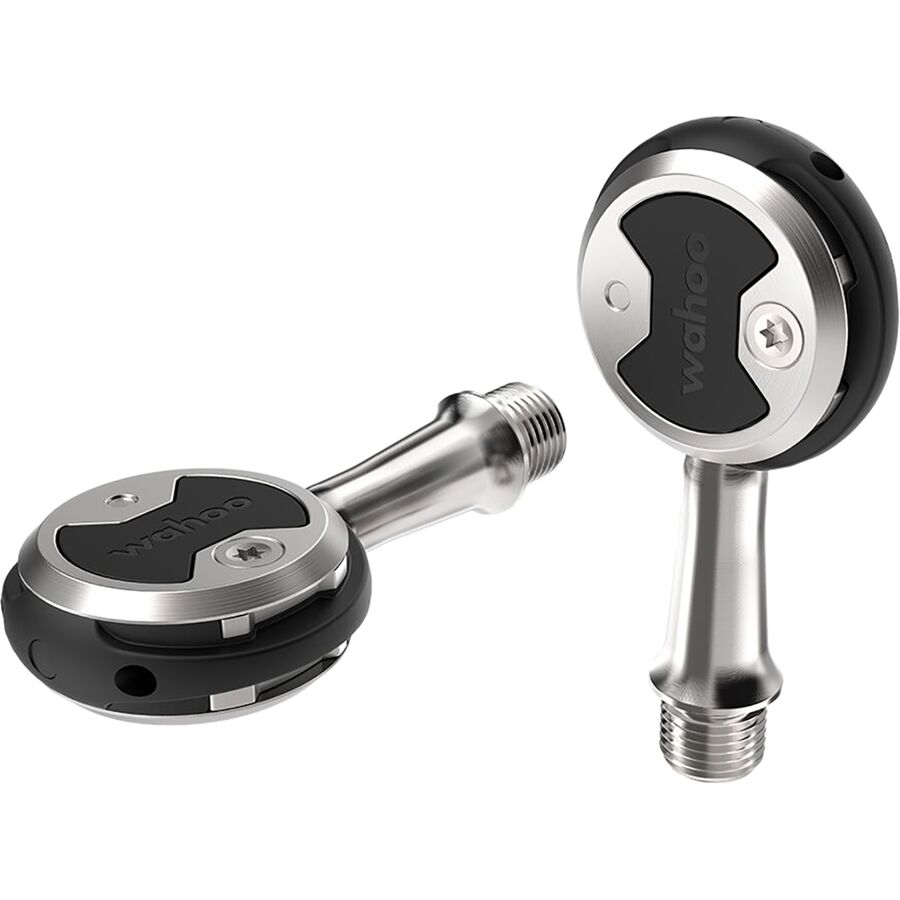
Speedplay pedals also come in less expensive and more expensive models. The major difference between them is the material used in the spindle rather than the pedal body itself.
The Wahoo Speedplay Comp model uses chrome alloy steel spindles coated in black. I’ve used these spindles in an uncoated version for years on a set of Speedplay pedals made before Wahoo took over. While they don’t look as shiny as the stainless steel used in the current Zero model, they’ve held up well with no hints of corrosion. They weigh only 10 grams more per pedal and come with what Wahoo calls the Easy Tension cleats rather than the Standard Tension ones included with the Zeros.
Except for changing the color of the plastic covers used to make walking easier from yellow to black, the Standard Tension cleats are identical to and cross-compatible with the ones Speedplay used for years on earlier Zero models. In normal use on the road, I couldn’t tell any difference clipping into and out of the Easy Tension cleats (they have grey covers).
For essentially the same performance but with a little less shine, the Speedplay Comp sells for US$80/£65/€65 less. They are available at the same links provided above, and I’d recommend them unless you prefer stainless spindles.
The higher-priced Wahoo Speedplay Aero road bike pedals are the same as the Speedplay Zero save for a dimpled cover on one side of the pedal. The Wahoo Speedplay Nano pedals use a titanium spindle that saves 56 grams per pedal at an added cost of about $2 per gram.
Unless you are a pro, racing in a wind tunnel, or have money to burn, there is no aero or climbing benefit that mere enthusiast mortals can gain from these features.
TIME
SRAM bought Time’s pedal line in 2021. Three years later, they introduced updated MTB, road, and commuter bike pedals. New ownership and investment from a financially sound company allow cycling consumers to focus on the product and not worry about whether it will be supported if there’s a service issue.
The latest Time pedals continue to combine a larger though narrower platform area than Shimano pedals. They also have more float than any pedals short of Speedpay and offer spindle lengths narrower than others and wider than all but Speeplay.
Time pedals clip in convincingly, are well made, and are as stable as Shimano and Speedplay while underway. The cleats aren’t as easy to get around in as any of their competitors, but unless you plan to spend a lot of time walking in them, that shouldn’t be a deal breaker.
As with the Shimano and Speedplay pedals, Time sells the XPRO 12 SL and XPRO 12 racer-level models, which cost more, stay clipped in when doing 1000+ watt sprints (per fellow tester Miles) but probably don’t make a noticeable performance difference than the XPRO 10 provides most cycling enthusiasts.
If Shimano brand gear isn’t your cup of tea and you don’t need or like the Speedplay design, Time pedals are a good alternative between the two. At an MSRP of US$160/£160/€180, the enthusiast-level XPRO 10 is also less expensive than the Shimano Ultegra and Wahoo Speedplay Zero.

You can find it at BTD (BikeTiresDirect) 10% off w/code ITK10, Competitive Cyclist, Performance Bike, and Merlin.
LOOK
I don’t recommend you buy Look pedals, the other major road pedal supplier.
Look’s enthusiast-level Keo 2 pedals don’t have as stable an interface between the pedal and cleats as the Shimano, Speedplay, or Time systems. This leads to less efficient power transfer and, in my experience and reports from many others, an annoying creaking sound that comes and goes.
While lower-priced, they aren’t as well built as those from the other road pedal brands.
WHAT MATTERS MOST
Five performance criteria matter most in choosing the best road bike pedals, and another four design aspects matter much less or at all. Durability and maintenance are the key quality criteria for pedals. Cost always matters but changes more with design specs than pedal performance.
Performance
Clip-In – Each pedal system’s approach to clipping in is somewhat different, but they each take a half dozen or so rides to get used to. Once you do, they all become second nature, and the only thing that differentiates them is personal preference.
Know It:
- You‘ll see some reviewers state that certain road bike pedals “perform” better than others because they clip in “easier.” Hogwash. It’s a personal preference rather than a performance difference.
- My
personal preferencehogwash? Historically, I’ve used Speedplay Zero pedals for their superior fit, float, and clip-in performance. - Time pedals also clip in easily and have a satisfyingly loud click that confirms you’re in.
- I’ve used single-sided Shimano Ultegra pedals and Look Keo pedals extensively, and I’m equally confident clipping into them as my Speedplays.
- While you can only clip into Shimano, Time, and Look pedals from one side, only Shimano pedals are weighted to orient themselves in a way that usually keeps the clip-in side up and angled at about 30 degrees to accept your cleat.
- Some people judge clip-in performance after the first couple of rides. This is misleading. It takes a few rides to get your muscle memory adapted to where to find the pedals and clip into them. I also find a bit of a “break-in” period for the spring mechanisms to work through the protective sealant applied at the factory and for cleat edges to wear a little so you get to a tension equilibrium.
Release – As with clipping in, each pedal system releases somewhat differently when you twist your heel out. But, all work effectively.
Know It:
- Shimano Ultegra, Time XPRO, and Look Keo 2 pedals use adjustable springs to set your release tension.
- Look Keo Blade pedals give you a choice of two or three carbon “blades” with pre-set tension levels instead of a spring.
- Speedplay uses a non-adjustable tension spring in its release mechanism (the float is adjustable – more below). Their Standard Tension cleats work fine for me at my 150lb/68kg weight. While I couldn’t tell any difference clipping in and out, they also make Easy Tension cleats that you might prefer if you weigh less or are new to riding clip-in pedals. The Easy Tension cleats come standard with the lowest-priced Comp model. You can buy either set of cleats separately for about US$50/£50/€60.
Stability – Once clipped in, you want an interface that is as stable and quiet as possible between your pedal and cleat. The more stable the interface, the more efficient your power delivery.
Know It:
- If the interface isn’t initially stable or as the cleat and pedal component facings wear down, you’ll feel play or rocking in your road bike pedals.
- If the interface isn’t quiet, it may still be stable. Creaking can be eliminated with regular cleaning and periodic dry lubing of the cleats (Speedplay) or replacement of the cleats with an aftermarket version (Exustar).
- Shimano, Speedplay, and Time pedals and cleats systems each give me a very stable, quiet connection with no perceptible play after many miles.
- Speedplays benefit from periodic dry silicon spray to lubricate the springs in the cleats.
- Look Keo 2 pedals develop an irritating creaking sound over time and after abrasion of the pedal surface.
Float – Float is a term used to quantify how much your heel can swing side to side when your foot is clipped in.
The more float you have, the more likely you can find a comfortable alignment between your knees and feet. But, the more your feet float, the less efficient your power transfer will be and the further you have to twist your foot to unclip from the pedal.
On the other hand, the less float you have, the more accurately your cleats need to be set up to avoid messing up your knees.
Know It:
- If you get your bike fit every few years, you can get your cleats set up for the right alignment and amount of float.
- Most pedal systems offer a choice of cleats, each with a different amount of float.
- Shimano Ultegra pedals come standard with 6-degree yellow-colored cleats (+/-3 degrees from the center), and offer 0-degree (red) and 2-degree (blue) cleat options
- Look Keo pedals come with 4.5-degree grey cleats, with 0-degree (black) and 9-degree (red) options
- Time’s standard cleats have 10 degrees of angular (rotational) float and 2.5mm of lateral (side-to-side) float. They also offer a fixed cleat with no float.
- Speedplay Zero pedals include one set of cleats that can be set between 0 and 15 degrees of float.
- Speedplay’s float is nearly frictionless and feels totally free; Shimano and Time cleat float have somewhat more friction, and Look’s has more still. This is more of a fit preference than a performance difference.
Axle Length – Most pedal systems come standard with between 51 and 53mm long axles between the crank and centerline of the pedal. This distance is called the “Q-Factor.” If you have wide hips, some hip or leg asymmetry, or limited flexibility, you may need longer axles or “spindles” to make pedaling more efficient and more comfortable.
Know It:
- A good bike fit will determine if your performance and comfort can be improved by riding road bike pedals with longer axles.
- Shimano’s Ultegra and Dura-Ace standard road bike pedals have 52mm long axles and are also available with 4mm longer ones. Time pedals are offered in 51, 53, and 57mm long axles. Speedplay offers 53, 55, 59, and 65mm long axles on the Zero models later. Look Keo pedals are offered only with 53mm long axles.
- You can typically put 1-2mm washers between the crankarm and pedal threads to extend your effective pedal length or Q-Factor.
Quality
Durability – Bearing wear, water resistance, spring fatigue, pedal body integrity, interface material wear, and cleat wear are all considerations in considering durability.
Know It:
- Shimano Ultegra and Speedplay Zero pedals are clearly better made and more durable than Look Keo pedals. The pedal plates that interface with the cleats don’t wear as well on the Look pedals. In my experience, the Look bearings and cleats also don’t hold up as long.
- While I’ve not ridden the updated Time pedals long enough to assess their durability, they appear to be very well made. The bearings run smoothly and you don’t feel any play in the joints between the pedal shell and spindle.
Maintenance – You need to do some routing maintenance on all of these road bike pedals to get the full useful life out of them.
Know It:
- Speedplay cleats require dry lubing in the spring mechanisms every few hundred miles or kilometers, or about as often as you lube your chain. They (both your cleats and chain) can get gunked up in dirt or sand. So, while it’s simple to keep them cleaned and lubed, you have to commit to doing it.
- At the other end of the scale, you can pretty much ignore maintaining Shimano Ultegra pedals and cleats and still sleep (and ride) well. To maximize their longevity, you should clean and regreasing the axle every year or so.
- Look Keo cleats need to be regularly cleaned off to avoid creaking while pedaling (and that doesn’t always work). Cleaning and regreasing the Look axles periodically will also get the most out of them, though you may give up on these cleats from the creaking long before they need to be greased.
Cost
Shimano, Look, Speedplay, and Time each make different levels of road bike pedals to serve the range of road cyclists, from recreational riders to racers. The pedals run from as little as $40, £35, €35, less than what you pay for a tire, to 10-15x that amount, a sum that you would pay for an alloy upgrade wheelset. Yeah, really!
Getting cleats with more or less float or longer axles that aren’t standard can add to the cost.
As with other categories of bike gear, the highest-priced pedals are generally lighter, have higher strength-to-weight materials, have design specs that claim to provide higher performance levels, etc. While weight-weenies and prestige buyers may see some value in these attributes, they make little, if any, noticeable performance difference to road cycling enthusiasts.
Design
Much is made of the four design features I describe below in the marketing of some pedal systems. For most road cycling enthusiasts, they don’t affect your performance much, certainly not to the level of the five performance characteristics described earlier, if at all.
I’ve listed them roughly in order of their relative potential impact on performance.
Stack height – Stack height is the distance between your foot and the pedal. The theory goes that the lower your stack height, the more efficient your power transfer as there is less getting between the source of your power and where it is being applied.
Shoes have a stack height – the sum of the thickness of your shoe’s insole and outsole. Pedal cleats attached to your outsole and add to your overall stack height.
Know It:
- The stiffness of your shoe’s outsoles and stability of the interface between your cleats and pedals will matter much more to power transfer than a few millimeters difference in stack height.
- All things being equal – a stiff sole, a stable interface, a limited amount of float, good pedaling mechanics, etc. – there’s little difference between the road bike pedals I’ve recommended or the more expensive versions. The Look pedals do have considerably more stack height than the others, but it’s hard to quantify the effect on performance.
- Perhaps the most important thing to do with the knowledge of your stack height is to raise or lower your seat to compensate for any change in stack height from a new set of pedals (or shoes).
Weight – As with all things cycling, weight is promoted well beyond its importance. And, as with other cycling gear, the credibility of a claimed pedal system weight is suspect. Further, some companies give you both their claimed pedal and cleat weights, whereas others just give you the pedal weight.
Know It:
- Most road cycling enthusiasts will not notice the 20 grams or so difference per pedal, the most you’ll find in the road bike pedal systems for cycling enthusiasts I’ve reviewed in this post.
- Speedplay may have lighter pedals, but the clip-in spring mechanism is found in the cleats, making the cleats and total system heavier than the others. Look at the sum of the weights of the pedals and cleats rather than just the pedal weights.
Walkability – No road bike cleats make walking easy. Speedplays are perhaps the best to get around in. Shimano and Keo cleats are a bit less so, whereas Time’s cleats require more concentration when navigating around the garage or coffee shop. You’ll be safe in any of these as long as you do so deliberately.
Know It:
- Cyclocross, gravel, commuting, or recreational cyclists who do a good deal more walking or running than roadies are the only road cyclists who should buy a pedal system based on how well you can walk in their cleats. In those cases, mountain bike pedals (and shoes) are a better solution.
Platform Area – The idea behind this design feature is that your power is transferred more effectively by a wider or larger platform between your feet and the pedals.
Some pedal companies define the platform as the area at the intersection of pedal and cleat. Others feel the key measure should be the area where the shoe and cleat meet. Some emphasize the width of the platform, while others promote the area of the platform.
Know It:
- None of this matters for road cycling enthusiasts who wear the best road bike shoes that fit well without your feet or heel moving and have stiff carbon outsoles. If you don’t have shoes with those characteristics, a bigger platform area (however defined or measured) won’t help you much compared to those who do.
WHERE TO FIND THE BEST ROAD BIKE PEDALS
If you want to buy other pedals in the Shimano, Look, or Speedplay lines beyond those I’ve recommended, here are the links to the listings at online stores with a good selection of each, the most competitive prices, and top customer satisfaction ratings.
Shimano Dura-Ace, Ultegra, and 105: BTD (BikeTiresDirect) 10% off w/code ITK10, Competitive Cyclist, Performance Bike, Merlin, and Sigma Sports.
Wahoo Speedplay Nano, Aero, Zero, and Comp: BTD (BikeTiresDirect) 10% off w/code ITK10, Competitive Cyclist, and Sigma Sports.
Time XPRO and XPRESSO: BTD (BikeTiresDirect) 10% off w/code ITK10, Competitive Cyclist, Performance Bike, and Merlin.
Look Keo: BTD (BikeTiresDirect) 10% off w/code ITK10, Competitive Cyclist, Performance Bike, Merlin, and Sigma Sports.
* * * * *
Thank you for reading. Please let me know what you think of anything I’ve written or ask any questions you might have in the comment section below.
If you’ve benefited from reading this review and want to keep new ones coming, buy your gear and kit after clicking the store links in this review and others across the site. When you do, we may earn an affiliate commission that will help me cover the expenses to create and publish more ad-free, subscription-free, and reader-supported reviews that are independent, comprehensive, and comparative.
If you prefer to buy at other stores, you can still support the site by contributing here or by buying anything through these links to eBay and Amazon.
You can use the popup form or the one at the bottom of the sidebar to get notified when new posts come out. To see what gear and kit we’re testing or have just reviewed, follow us by clicking on the icons below.
Thanks, and enjoy your rides safely! Cheers, Steve
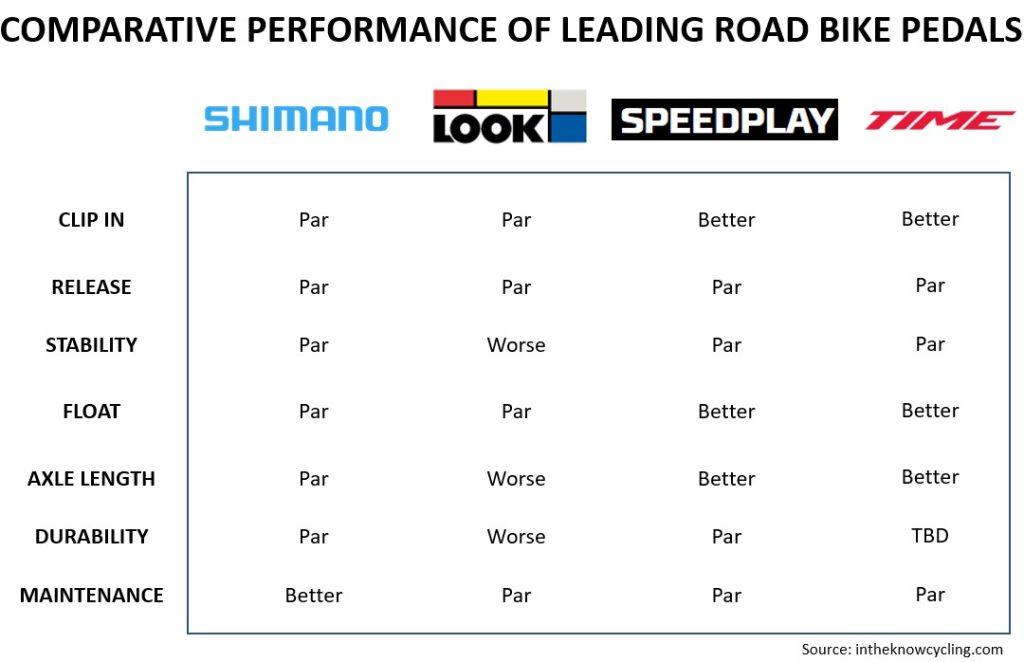
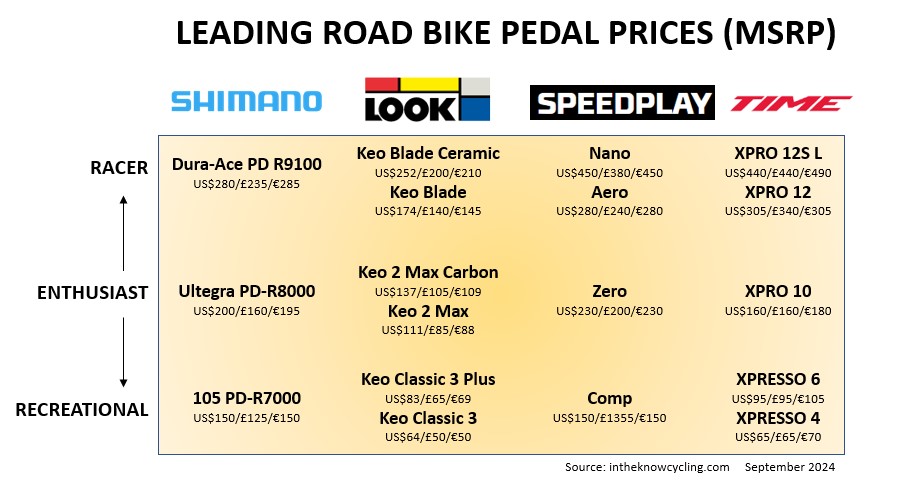
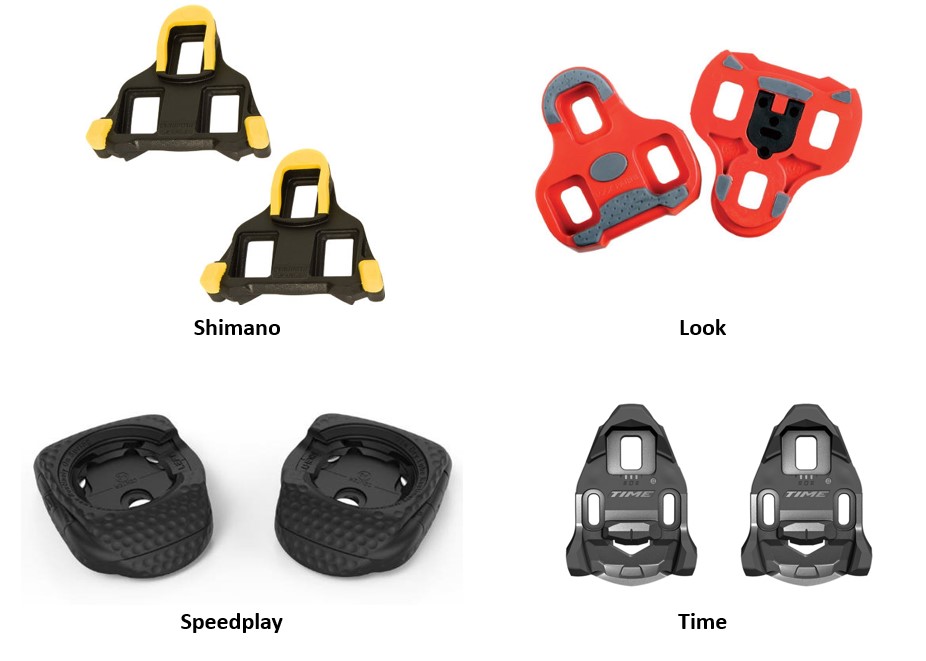
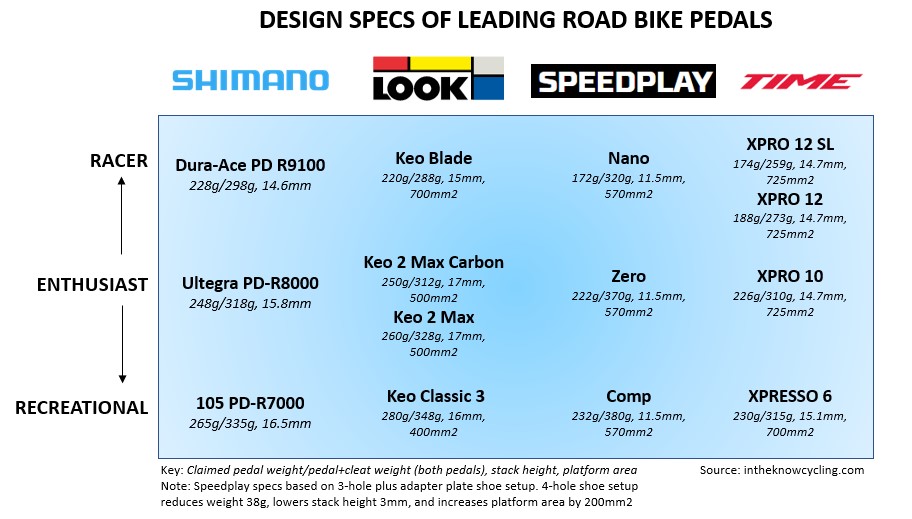
Just to note, because I learned this the hard way … Dura-ace pedals are not compatible with Favero Duo-Shi power meter spindles. Ultegra are.
Also, I discovered that the wider Q-factor that comes with the Duo-Shi spindles is very nice for my knees. I added several axle spacers to my other bike to increase the Q-factor and my knees track better, I have less discomfort on long rides. Perhaps as an MTBer, the wider Q is more natural for me.
Older speed play x1,x2,x3 pedals are bulletproof and durable for 50k +miles. Wahoo is making a serious mistake by not continuing production of replacement cleats . Absent that I’m going Shimano next …
Having used Shimano, Time and Speedplay extensively, I would perhaps disagree with some of the ratings here. In particular, Time pedals (I really wanted to love these, given the light weight) have some significant durability issues. They are nowhere near Shimano in this regard, and all versions I used would develop clicking / creaking issues. In addition, they shouldn’t really be rated ‘Par’ for maintenance IMO, given that officially, they aren’t supposed to be maintained by the user (albeit you can do). Stability wise, Shimano are superior to Time (and far better than Speedplay). Personal opinion, but it is difficult to look past Shimano as far as pedals are concerned. They have the lightest (cleat plus pedal) weight, are good value, have a great stable platform and enviable durability.
David, thanks for your input. I agree with your comments about Time pedals prior to the latest models. I didn’t include them prior to the latest update of this review because of their poor durability record. As you may know, SRAM bought the Time pedal business a few years ago and introduced updated models this year including the top tier XPRO 12 and XPRO 10 that Miles and I tested for this review update. It’s too soon to judge their durability (and that’s why I rated them TBD), but maintaining them is on the same level or Par with Look and the Wahoo-owned Speedplay models. I also agree that stability is a personal issue – some will favor the width Shimano, Speedplay or Time – but the difference between them isn’t so great that I can say one is clearly better or worse than the others. That’s why I put them all at Par. Look Keo pedals are clearly worse and rated that way. Finally, I agree with the points you make about the strengths Shimano pedals but Speedplay and Time offer some other benefits around float and q-factor options that Shimano don’t and, from my experience, don’t clip in as easily as those pedals. Cheers, Steve
DA pedals have the extended axle too but even with that they are still slightly narrower than Ultegra. Also have a lower stack height, and three bearings one of which is needle bearing. 3 year warranty vs 2 for Ultegra. Comes with I think the blue cleats so if want maximum float will have get your own yellow cleat’s. Also lighter but I’m not a weight weenie. I have found DA pedals for as low as $224.
I have not tried the latest Times but have seen good reviews and they are wider now with 3 axle lengths. Apparently they improved the cleat durability too. I haven’t ridden Times since the early 90’s though. Weird that Time still makes bikes but sold their pedal brand to SRAM.
It sounds like you only rode the Look Keo’s, which are ancient at this point. Strange to trash an entire brand off one of their oldest offerings especially with the new Blades out which appear to be improved in many ways. Your other reviews are much more thorough and detailed, this one is minimal at best. I personally have not owned Looks in a very long time but I did have their first clipless pedal in 1984…